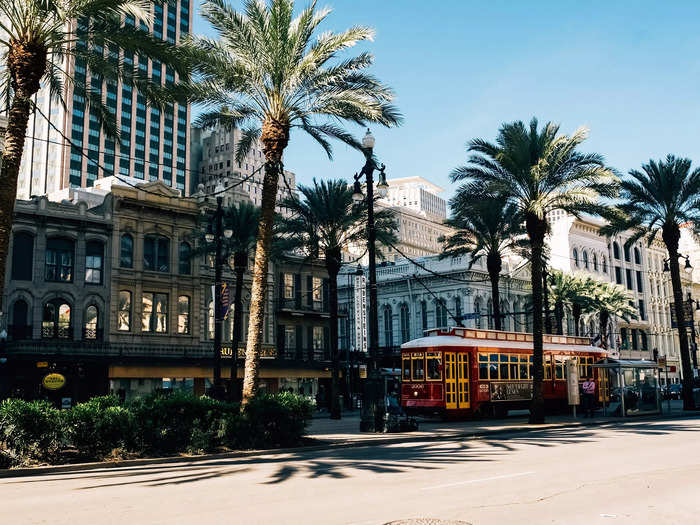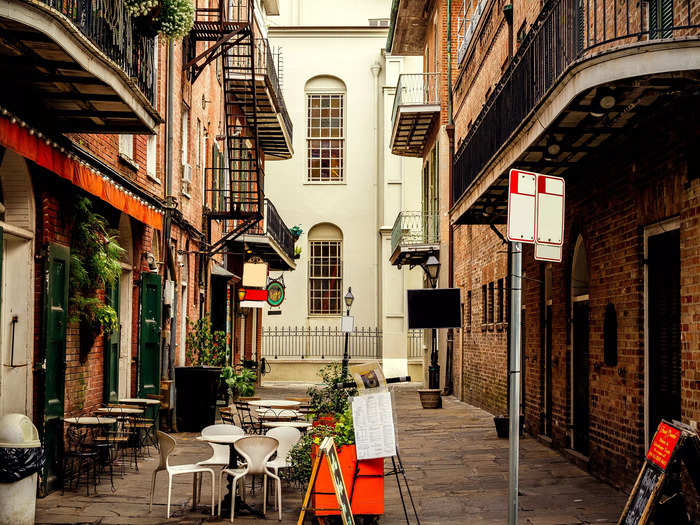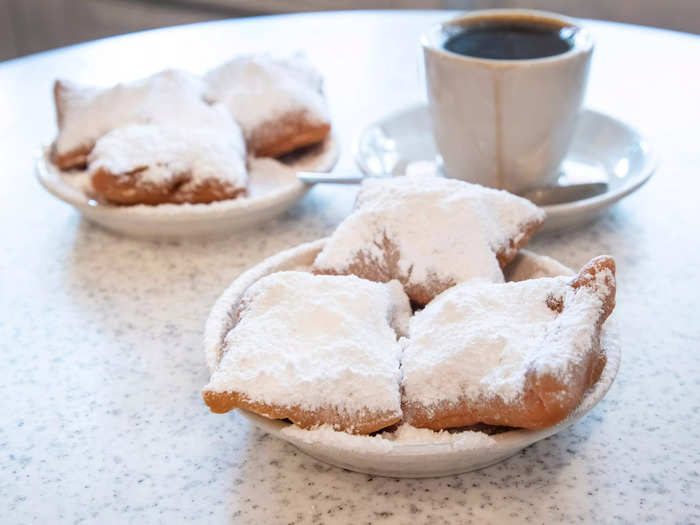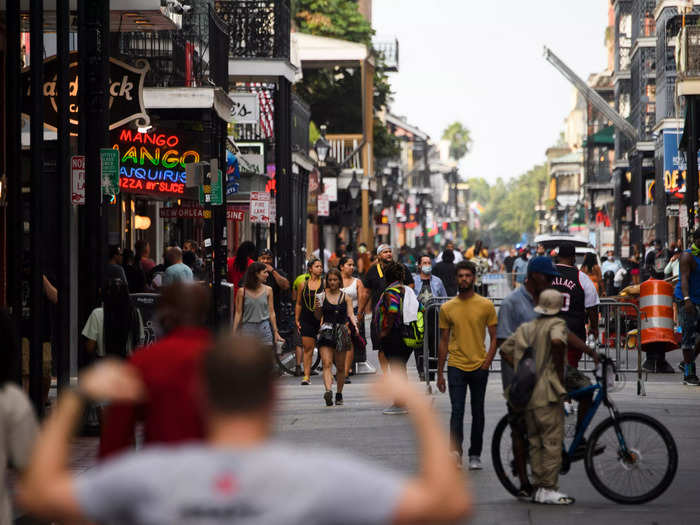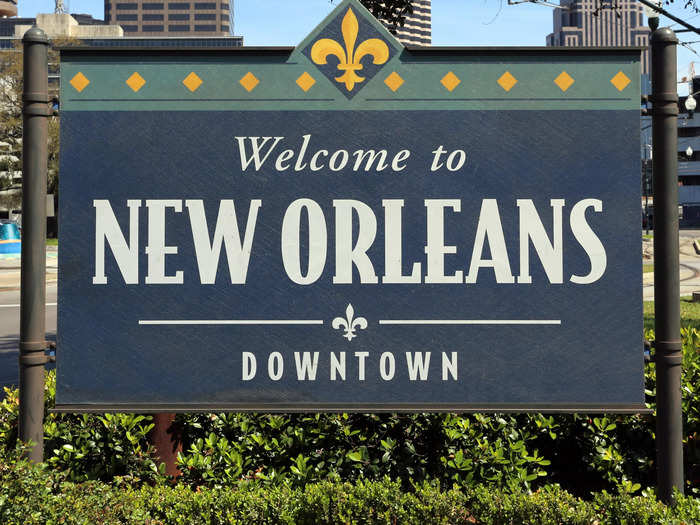The Saint Louis Cathedral, located in the French Quarter, is the oldest Cathedral in North America.Cavan Images/Getty Images
Table of Contents: Masthead Sticky
- New Orleans is a vibrant destination that celebrates music, food, and festivals at every corner.
- There are hotel, restaurant, and activity options when planning a trip to the Big Easy.
New Orleans, aka the Crescent City or the Big Easy, is a small city in the Deep South with a big reputation. European, Caribbean, and African influences have combined here over three centuries, creating an American city like no other. It's an ebullient, dynamic destination where the locals celebrate life daily through the music, food, and festivals that define the city's character, most notably Mardi Gras, perhaps the biggest free party on Earth.
The historic French Quarter, the tourist hub, boasts hundreds of years of tradition, apparent in its distinctive architecture. Walk around the Quarter or the equally historic African American neighborhood of Treme and feel 300 years of history bubbling up from the streets. Live music emanates from almost every street downtown, from the jazz clubs of Frenchmen Street to the lively rooms of Preservation Hall to the brass bands that set up in Jackson Square and play for passersby.
With parades for everything from weddings to funerals, everyday life has been raised to an art form. Irresistible Cajun and Creole dishes make New Orleans the country's most interesting foodie destination. The choice of restaurants, from high-end to hole-in-the-wall, is world class. Restaurants serve traditional and updated versions of classics such as gumbo and jambalaya, as well as some of the country's best fresh seafood and a host of home-grown cocktails.
There are cultural and music festivals year-round, with Jazz Fest in the spring, Voodoo Fest in the fall, and Satchmo Fest in the summer.
Parks and green spaces abound, from the lush sprawl of City Park to the breezy banks of the mighty Mississippi River, replete with steamboats and ferries.
New Orleans is a vital and proud city - a destination that offers a warm welcome to anyone with an open mind and a sense of adventure.
Getting to and around New Orleans
The photogenic streetcars have been a part of the city’s landscape for over a century.
Getty Images
For an American metropolis, New Orleans is a fairly compact and relatively easy place to navigate. The city is served by Louis Armstrong New Orleans International Airport, which recently got a multimillion-dollar upgrade. Only a couple of international flights to Canada and Mexico operate out of this airport, so you're likely to arrive from a layover at another US hub.
Cabs and cars into the city are reasonably priced — it's a 20-minute drive from the airport to downtown. There's also an affordable airport shuttle that makes the rounds to downtown hotels. Since accommodations are concentrated in the city center, most visitors tend to stay in the French Quarter or the Central Business District, both of which are easily navigated on foot.
The photogenic streetcars have been a part of the city's landscape for over a century, connecting visitors and transporting locals to various neighborhoods. The popular St. Charles Avenue streetcar heads uptown and back, delivering a cheap tour of the affluent thoroughfare's famous mansions.
Buses serve the other downtown neighborhoods: the Marigny, the Bywater, Treme, and Mid-City. Visitors can buy multiday passes and download apps through the local transportation authority, the RTA.
New Orleans is flat, so renting a bicycle is a great idea. But do watch out for potholes.
Unless you're planning day trips out of town, car rentals aren't really necessary, and parking downtown is expensive and inconvenient. Outside of the oppressive summer heat, New Orleans is a pleasant city to walk around, so bring some comfortable shoes and take a stroll while taking in the architecture and street music.
Where to stay in the Big Easy
A view down an alleyway in the French Quarter, which includes a small open-air cafe.
Jonathan D. Goforth/Getty Images
Of course, New Orleans has its share of bland, midrange corporate hotels. But you don't have to stay in any of them. Historic preservation orders in the French Quarter and a general liking for the esoteric across the city mean accommodation options celebrate a sense of place.
Most of the hotels are in and around the historic French Quarter and its modernized neighbor, the Central Business District, with a few outliers in the beautiful Garden District. Some of the country's best historic properties are worth considering, like the pomp and grandeur of The Roosevelt Hotel and Le Pavillon. These hotels have been in business since the late 19th century, as has the fabulous Monteleone Hotel, a rare property now run by the fifth generation of the Monteleone family.
Upscale boltholes offering the most luxurious stays in town include Maison de la Luz, which recalls the mansion of a world explorer, or the new Kimpton Hotel Fontenot, with its decadent Peacock Room.
There's great value in staying at some of the newer Central Business District properties, such as The Troubadour, with its retro stylings and nods to the local music scene, or the hip and arty Old No. 77 Hotel, which has rotating exhibits from local creators. The Higgins Hotel neighbors the National World War II Museum and is filled with wartime memorabilia and evocative, era-specific touches.
Visitors wanting a buffer between themselves and the downtown nightlife might consider the Pontchartrain Hotel, which celebrates 1950s glamor and has fabulously detailed interiors as well as the best rooftop bar in town. Hôtel Peter & Paul, a converted church in the residential neighborhood of the Marigny, makes for a welcome change of pace.
Food and drinks to enjoy in New Orleans
Café du Monde opened in 1862 in the French Market.
Shanna Baker/robertharding/Getty Images
New York and San Francisco may have serious foodie chops, but for the most exciting and memorable culinary experience in America, New Orleans has the edge. Even well-traveled doyens, such as the late Anthony Bourdain, have put the Crescent City at the top of their lists.
It's hard to know where to start when deciding where to dine, but the classics are never a bad introduction. Don't be put off by thinking the famous places are too touristy — locals go everywhere in town, and these spots are successful for good reasons.
On your first day, eat beignets at Café du Monde, a muffuletta sandwich at Central Grocery, a po'boy at Parkway Bakery, and fresh oysters at Felix's (where you can avoid the lines and inflated prices at Acme across the street). Many restaurants feature at least a couple of dishes from the Creole and Cajun repertoires, and you can devour gumbo, jambalaya, and turtle soup at restaurants across the price spectrum.
Upscale enclaves such as the relatively new Restaurant R'evolution and institutions such as Arnaud's have refined surroundings, but a cup of gumbo from a dive bar such as Bar Redux hits the spot just as hard. If it's March, April, or May, find a crawfish boil at any neighborhood bar and join your new friends filling up on the city's best seafood at a long, ceremonious table.
During this family-style occasion, whet your appetite with a cocktail — New Orleans is considered the spiritual home of the mixed drink. There's a rye-whiskey concoction called the Sazerac that you should drink in the Sazerac Bar at The Roosevelt, or ask for a Ramos gin fizz or a grasshopper, both of which were invented in the city.
What to do in New Orleans
Bourbon Street is the life of the party, stretching 13 blocks from Canal Street to Esplanade Avenue. It also makes its way through the Marigny neighborhood.
Patrick T. Fallon/Contributor/Getty Images
While New Orleans has its share of landmarks and attractions, it excels in experiences. New Orleans is about making friends, whether that's through attending a Mardi Gras parade, rubbing elbows at a crawfish boil, or dancing while a jazz band plays on a stoop.
A word about Mardi Gras: The day itself is an all-consuming, citywide celebration. But come a week or two earlier and you'll find smaller, homegrown walking parades that are just as memorable.
Bourbon Street is noisy and boozy, but move beyond the neon and clamor. Music is the lifeblood of New Orleans, and Dixieland jazz lives on in the clubs of Frenchmen Street and in the crammed rooms of Preservation Hall. It's a city where live music comes to you, though — buskers, brass bands, and festival stages of all sizes pop up everywhere.
In terms of sightseeing, the National World War II Museum is a world-class attraction. The huge facility comprehensively details the war via state-of-the-art exhibits and video presentations.
The Deep South has a strong tradition in the visual arts, and prominent examples are on display at the Ogden Museum of Southern Art. The New Orleans Museum of Art features regional and international artists and has a very explorable sculpture garden. City Park, where NOMA is, has a plethora of activities from golf to nature trails.
The city embraces its inherent spookiness, and taking a guided tour of one of the cemeteries — with their aboveground tombs — is essential. A walking tour of some of the most decadent mansions on St. Charles Avenue can be combined with some antiquing and shopping in the boutiques on nearby Magazine Street. But New Orleans is about strolling, with a cocktail in hand, and joining locals doing what they love the most: sharing their city with visitors.
Local advisories for New Orleans
Pay attention to the city's local advisories when traveling to New Orleans.
wellesenterprises/Getty Images
Many people will tell you the culture in New Orleans is unlike that of any other city in America. Visitors spending time here soon find out that this is true. There are strong European, African, and Caribbean influences — throw in Catholicism, Voodoo, and a city motto of "Let the good times roll," and it's hard to imagine a similar place in North America.
Navigating New Orleans is easy, and as long as you respect the local traditions and some of the more idiosyncratic rules, visitors can find instant community and friendship.
As with any busy tourist destination, petty crime is something to keep in mind. Visitors should keep their wits about them when walking around, especially during busy events such as festivals. Avoid carrying valuables in your pockets or bags. And outside of Mardi Gras times, don't wear brightly colored beads — they're a neon sign that you're a tourist.
Take cabs after dark, especially traveling between neighborhoods. The city runs on a very hardworking service industry, and many bars are open 24 hours a day. You should plan to tip at least 20% to 25% in restaurants, 10% to 20% for cabs, and at least $1 per drink in bars — more if you're ordering fancy cocktails.
New Orleans is an open, tolerant city. It is majority Black and has a strong bohemian tradition. You can walk into bars and restaurants and be served next to drag queens, burlesque dancers, or maybe even the mayor.
All visitors should feel at home as long as they're respectful. A section of Bourbon Street has queer bars, and LGBTQ communities are supported and celebrated almost everywhere, especially downtown. It's legal to carry your drinks from bar to bar in plastic cups, but finish your cocktail before you enter the next establishment.

